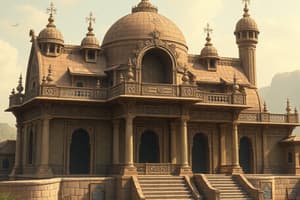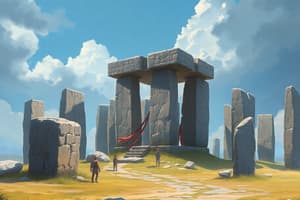Podcast
Questions and Answers
What is the generally accepted period for Byzantine architecture, according to the text?
What is the generally accepted period for Byzantine architecture, according to the text?
- 300 AD to 1450 AD (correct)
- 364 AD to 1450 AD
- 300 AD to 726 AD
- 330 AD to 1450 AD
The division of the Roman Empire into Western and Eastern empires occurred in which year?
The division of the Roman Empire into Western and Eastern empires occurred in which year?
- 300 AD
- 364 AD (correct)
- 330 AD
- 726 AD
Which architectural style is specifically associated with the western part of the Roman Empire during the early Byzantine period?
Which architectural style is specifically associated with the western part of the Roman Empire during the early Byzantine period?
- Roman Architecture
- Byzantine Architecture
- Syrian Architecture
- Early Christian Architecture (correct)
Which of the following was NOT a key influence in the development of Byzantine architecture?
Which of the following was NOT a key influence in the development of Byzantine architecture?
Which construction technique is a hallmark of Egyptian architecture?
Which construction technique is a hallmark of Egyptian architecture?
What is the term for walls that slope inward from bottom to top, a design element commonly found in Egyptian structures?
What is the term for walls that slope inward from bottom to top, a design element commonly found in Egyptian structures?
What function do pendentives serve in Byzantine architecture?
What function do pendentives serve in Byzantine architecture?
In Egyptian architecture, what does the placement of pyramids and temples on the west bank of the Nile River symbolize?
In Egyptian architecture, what does the placement of pyramids and temples on the west bank of the Nile River symbolize?
Which of the following best describes the typical interior of Byzantine buildings?
Which of the following best describes the typical interior of Byzantine buildings?
What type of plan is NOT typically used in a Byzantine church?
What type of plan is NOT typically used in a Byzantine church?
What primary material was NOT commonly used in the construction of Egyptian buildings?
What primary material was NOT commonly used in the construction of Egyptian buildings?
Which type of construction materials were most commonly used in Byzantine architecture?
Which type of construction materials were most commonly used in Byzantine architecture?
What architectural element, believed to have originated with the Etruscans, was integrated into Roman architecture?
What architectural element, believed to have originated with the Etruscans, was integrated into Roman architecture?
What is the term for the decorative panels of enameled or glazed bricks that are NOT a primary feature of Egyptian architecture?
What is the term for the decorative panels of enameled or glazed bricks that are NOT a primary feature of Egyptian architecture?
Which of the following best describes the planning of Egyptian buildings?
Which of the following best describes the planning of Egyptian buildings?
What was a major influence on the design and placement of structures in ancient Egypt?
What was a major influence on the design and placement of structures in ancient Egypt?
What is a defining characteristic of the architecture during the Aegean Period?
What is a defining characteristic of the architecture during the Aegean Period?
Which of the following was NOT a significant structure in ancient Greece?
Which of the following was NOT a significant structure in ancient Greece?
What optical refinement was introduced during the Hellenic Period to correct optical illusions in columns?
What optical refinement was introduced during the Hellenic Period to correct optical illusions in columns?
Which element characterizes the capital in Aegean period columns?
Which element characterizes the capital in Aegean period columns?
What were the primary materials used in constructing Greek architecture after the wooden structures?
What were the primary materials used in constructing Greek architecture after the wooden structures?
What was the main purpose of the structures in Mesoamerican cultures?
What was the main purpose of the structures in Mesoamerican cultures?
Which of these correctly represents a traded item in Kaminaljuyu?
Which of these correctly represents a traded item in Kaminaljuyu?
What is a legacy of Mesoamerican architecture on modern Mexican culture?
What is a legacy of Mesoamerican architecture on modern Mexican culture?
Flashcards
Byzantine Architecture
Byzantine Architecture
A type of architecture that emerged from the Eastern Roman Empire, characterized by its use of arches, domes, and elaborate mosaics.
Constantinople
Constantinople
The capital city of the Eastern Roman Empire, a significant center for the development of Byzantine architecture.
Pendentives
Pendentives
A structural element that allows a dome to be placed over a square space by transferring weight to the piers below.
Arches and Domes
Arches and Domes
Signup and view all the flashcards
Emphasis on Interiors
Emphasis on Interiors
Signup and view all the flashcards
Longitudinal (Basilican) Plans
Longitudinal (Basilican) Plans
Signup and view all the flashcards
Centralized (Circular or Polygonal) Plans
Centralized (Circular or Polygonal) Plans
Signup and view all the flashcards
Combination of Basilican and Centralized Plans
Combination of Basilican and Centralized Plans
Signup and view all the flashcards
Enameled Brick Friezes
Enameled Brick Friezes
Signup and view all the flashcards
Glazed Tiles
Glazed Tiles
Signup and view all the flashcards
Mesopotamian Architectural Influence
Mesopotamian Architectural Influence
Signup and view all the flashcards
Key Features of Egyptian Architecture
Key Features of Egyptian Architecture
Signup and view all the flashcards
Axial Planning
Axial Planning
Signup and view all the flashcards
Trabeated Construction
Trabeated Construction
Signup and view all the flashcards
Battered Walls
Battered Walls
Signup and view all the flashcards
Hieroglyphic Decoration
Hieroglyphic Decoration
Signup and view all the flashcards
Pyramid of the Sun
Pyramid of the Sun
Signup and view all the flashcards
Volcanic Tube Cave in Teotihuacan
Volcanic Tube Cave in Teotihuacan
Signup and view all the flashcards
Kaminaljuyu
Kaminaljuyu
Signup and view all the flashcards
Temples in Mesoamerican Cultures
Temples in Mesoamerican Cultures
Signup and view all the flashcards
Ball Courts in Mesoamerican Cultures
Ball Courts in Mesoamerican Cultures
Signup and view all the flashcards
Greek Architecture
Greek Architecture
Signup and view all the flashcards
Aegean Period of Greek Architecture
Aegean Period of Greek Architecture
Signup and view all the flashcards
Hellenic Period (Classical) of Greek Architecture
Hellenic Period (Classical) of Greek Architecture
Signup and view all the flashcards
Study Notes
Prehistoric Architecture
- Spans from Paleolithic to megalithic structures
- Shows human ingenuity in construction
- Reflects cultural and spiritual beliefs
- Shows relationship between early humans and their environment
- Early architecture focused on providing shelter and safety
Key Characteristics and Principles
- Functionality: Multifunctional role (shelter, storage, social interaction)
- Materials: Wood, stone, clay (varied by region)
- Techniques: Stacking stones, timber frames, mud walls
- Symbolism: Reflected cultural identity, values, spiritual beliefs
Types of Prehistoric Structures
- Temporary Dwellings:
- Tipi: Portable Indian shelter
- Beehive Hut (Clochan): Stone beehive-shaped hut with corbelled roof
- Trullo: Traditional Italian stone dwelling with conical vaulted roofs
- Wigwam: American Indian dwelling (round or oval, bark, rush mats, skins)
- Hogan: Navaho Indian dwelling (poles, bark, mats, animal skins, or sod)
- Igloo: Eskimo house (snow or ice blocks)
- Permanent Structures:
- Megalithic Tombs: Tumuli (artificial mounds of earth or stone, usually over a grave)
Mesopotamian Architecture
- Characterized by monumental structures (temples, palaces)
- Built with mud-brick and glazed brick
- Reflects religious beliefs, power of rulers, urban needs
- Materials: Mud-brick, burnt and glazed brick, stones
- Techniques: Built on ruins, articulated walls by pilasters and recesses, friezes, colorful tiles
- Religious Significance: Temples and ziggurats (stepped structures) for worship
Egyptian Architecture
- Characterized by massive scale, axial planning, and precise stonework
- Monumental tombs and temples
- Reflects a preoccupation with the afterlife and the worship of deities
- Trabeated construction (post-and-lintel)
- Decoration of battered walls with pictographic carvings in relief
- Materials: Limestone, sandstone, granite
- Types of Structures: Pyramids, temples, tombs
Mesoamerican Architecture
- Diverse styles reflecting unique beliefs (Olmec, Maya, Aztec)
- No use of the wheel or animals
- Constructed with stone, earth, stucco
- Monumental scale, aligned with nature, reflected cosmic and spiritual beliefs
- Structures often serve religious and social purposes.
- Types of Structures: Pyramids, temples, ball courts, urban centers
Greek Architecture
- Known for delicacy of outline, refined proportions
- Evolved from simple wooden to limestone/marble
- Features: Columns, marble, murals
- Types of Structures: Temples (various styles by column numbers - enostyle, distyle, etc ), public buildings, theaters, stoas
Etruscan Architecture
- Unique style, influenced by Greeks, but developed independently
- Predominantly mud-bricks and terracotta
- Notable innovations: Arch, vault, dome (precursors to Roman techniques)
- Types of Structures: Temples, tombs
Roman Architecture
- Ostentatious interiors, austere exteriors
- Characterized by innovation with concrete, arches, vaults, and domes
- Materials: Concrete, marble, granite, wood
- Types of Structures: Temples, basilicas, theaters, aqueducts, baths
Early Christian Architecture
- Emerged due to the spread of Christianity in the Roman Empire
- Mostly adapted Roman Basilica plan
- Focus on internal design (mosaics, frescoes)
Byzantine Architecture
- Associated with the Eastern Roman Empire
- Characterized by masonry construction (brick, stone, concrete)
- Features: Domes, arches, piers
- Internal decoration: Mosaics, frescoes, colors
- Types of Structures: Churches (combination of basilicas and centralized plans)
Studying That Suits You
Use AI to generate personalized quizzes and flashcards to suit your learning preferences.




